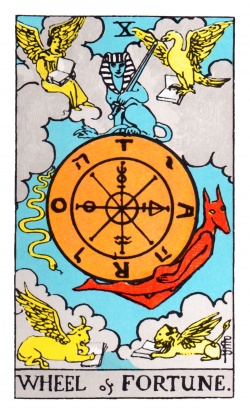The Wheel of Fortune
An Avatar.Global Resource
The Wheel of Fortune
The Wheel of Fortune is an Old Energy Archetype from the Masonic Tarot Deck. In the Book of Slavery and Book of Power, the archetype is used to reinforce class hierarchies, power, and authority, and also the idea that there should be a "balance" between good and evil.

List of Old Energy Archetypes from the Masonic Tarot
Chariot, Death (archetype), Duality, Hermit, Hierophant, High Priestess, Judgement, Justice, Star, Strength, Sun (archetype), Temperance, The Devil, The Emperor, The Empress, The Fool, The Hanged Man, The Lovers, The Magician, The Moon, The Tower, The Wheel of Fortune, The World (old energy)
Related Terms
Old Energy Archetypes > Book of Slavery
Notes
Book of Power
Papus emphasizes BALANCE, "command," "supremacy." "The wheel of fortune suspended upon its axis. To the right Anubis, the genius of good ascending; to the left Typhon, the genius of evil descending, the Sphinx is balanced upon the centre of the wheel, holding a sword in its lion claws."[1]
"(The Wheel of fortune; the Apprentice displaying his initiative.) In the centre of himself, the Initiate perceives the Warm Hearth which corresponds to the column of ]: his wages as Apprentice are expressed in an energy of which he has an inner source, that makes him undertake tasks with daring, but never without regard to fitness....the Mason sets to his task when the time has come for the work to be started."[2] p. 171.
Self-referential. Used to bolster the supposed authority of the tarot. "ROTA TARO ORAT TORA ATOR, which may be translated thus: (The) WHEEL, TARO, SPEAKS (the) LAW (of) HATHOR." [3]
Dialectical "mixing" "It is the revolution of experience and progress, the steps of the Zodiac, the revolving staircase, held in place by the changing influence of Light and Darkness..." [4]
Conciliation: " Conciliation implies concord, agreement, sympathy, peace, amity, and tranquility. The law here shown is that which reconciles appar- ent differences, which enables us to harmonize the elements of existence, which leads to the winning over of seemingly antagonistic forces, which conduces to peace and prosperity."[5]
Book of Slavery
Excuse and justification: "In Thomas Malory's version of the King Arthur story we find the suggestion that the Wheel symbolizes the random turnings of 'luck'. Why do some people get rich and others poor? Why should a powerful king fall, and a formerly weak one rise to power? Who, or what, controls the turning wheel of life? Malory suggests that luck, seemingly meaningless ups and downs, is in reality fate; that is, the destiny God has chosen for each individual, based on reasons only God can understand." [7] Things happen because of spirit, but for reasons we do not always understand.
"...we find that fate is also an illusion, a dodge to cover up the fact that we, with our limited vision, cannot see the inner connection between all things. 'Oh well,' we say, 'it's fate', a meaningless statement because we cannot understand the meaning. Things do not just happen, they are made to happen. The power to shape events, to give life and form and purpose to the universe, belongs, Malory tells us, to the Holy Ghost, dwelling in the physical world as a presence within the Holy Grail (the Ace of Cups) in the same way that the Shekinah physically dwelt within the veiled sanctuary of the temple at Jerusalem."[8]
Judge and Punish: "The ever-turning Wheel of Life came to signify the laws of karma, leading you to reincarnate in one body after another. Now, karma is in a way simply another explanation for the mystery of fate. By the actions you take in one life, you build up a certain destiny for yourself in the next, so that if you commit a great many evil deeds you create in your immortal self a kind of psychic need for punishment. When the time comes for your next incarnation you inevitably choose a low caste or diseased body. (This simple psychological explanation of karma is perhaps based more on Buddhism than Hinduism.)[9]
Citation and Legal
Treat the SpiritWiki as an open-access online monograph or structured textbook. You may freely use information in the SpiritWiki; however, attribution, citation, and/or direct linking are ethically required.
Footnotes
- ↑ Papus, The Tarot of the Bohemians (Wilshire Book Co, 1978), https://sacred-texts.com/tarot/tob/index.htm.
- ↑ Wirth, Oswald. Tarot of the Magicians: The Occult Symbols of the Major Arcana That Inspired Modern Tarot. San Francisco. CA: Weiser Books, 1990.
- ↑ Case, Paul Foster. An Introduction to the Study of the Tarot. New York: Kindle Edition, 1920.
- ↑ Wang, Robert. An Introduction to the Golden Dawn Tarot. Main: Sam Weiser, 1978. p. 139.
- ↑ Case, Paul Foster. Learning Tarot Essentials: Tarot Cards for Beginners. Vancouver: Ishtar Publishing, 1932. p. 104
- ↑ Case, Paul Foster. Learning Tarot Essentials: Tarot Cards for Beginners. Vancouver: Ishtar Publishing, 1932. p. 104
- ↑ Pollack, Rachel. Seventy-Eight Degrees of Wisdom. Harper Collins, 1980. p. 84.
- ↑ Pollack, Rachel. Seventy-Eight Degrees of Wisdom. Harper Collins, 1980. p. 85-6.
- ↑ Pollack, Rachel. Seventy-Eight Degrees of Wisdom. Harper Collins, 1980. p. 85-6.
[Is related to::Fool in School| ]]
{{#seo: |author="Mike Sosteric" |title=Tarot Card Meanings Old Energy |title_mode=append |keywords=tarot, freemasons, freemasonry |site_name=The SpiritWiki |description=The Old Energy Masonic Meanings of The Wheel of Fortune }}
